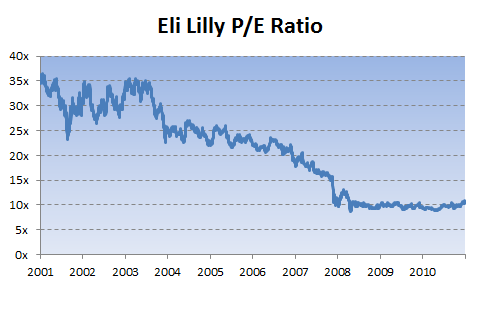A Brief History of Eli Lilly's Returns
Despite constant attempts by analysts and the media to complicate the basics of investing, there are only three ways a stock can create value for shareholders:
Dividends.
Earnings growth.
Changes in valuation multiples.
In this series, we drill down on one company's returns to see how each of those three has played a role over the past decade. Step on up, Eli Lilly (NYS: LLY) .
Eli Lilly shares returned a negative 33% over the past decade. How'd they get there?
Dividends softened the blow. Without dividends, shares returned negative 53% over the past 10 years.
Earnings growth was, surprisingly, decent. Eli Lilly's normalized earnings per share grew at an average rate of 4.6% a year from 2001 until today. That's pretty close to the broader market average, and better than either Pfizer (NYS: PFE) or Merck (NYS: MRK) achieved.
But if earnings were decent, why were shareholder returns downright terrible? This chart helps explain it:

Source: S&P Capital IQ.
Eli Lilly shares were grossly overvalued 10 years ago and have spent the better part of the past decade watching earnings multiples fall. That's prevented all of the company's earnings growth from showing up in shareholder returns.
The good news is that, with shares now trading at around 10 times earnings, Eli Lilly looks reasonably valued, if not cheap. Shareholders had to endure collapsing valuation multiples over the past decade. The coming decade could bring stable, even rising, multiples, providing a well-deserved boost for patient investors.
This stuff may seem basic, but it's worth paying attention to. It's important to know not only how much a stock has returned, but also where those returns came from. Sometimes earnings grow, but the market isn't willing to pay as much for those earnings. Sometimes earnings fall, but the market bids shares higher anyway. Sometimes both earnings and earnings multiples stay flat, but a company generates returns through dividends. Sometimes everything works together, and returns surge. Sometimes nothing works and they crash. All tell a different story about the state of a company. Not knowing why something happened can be just as dangerous as not knowing that something happened at all.
Add Eli Lilly to My Watchlist.
At the time thisarticle was published Fool contributorMorgan Houseldoesn't own shares in any of the companies mentioned in this article. Follow him on Twitter, where he goes by@TMFHousel.Motley Fool newsletter serviceshave recommended buying shares of Pfizer. Try any of our Foolish newsletter services free for 30 days. We Fools don't all hold the same opinions, but we all believe that considering a diverse range of insights makes us better investors. The Motley Fool has a disclosure policy.
Copyright © 1995 - 2011 The Motley Fool, LLC. All rights reserved. The Motley Fool has a disclosure policy.

